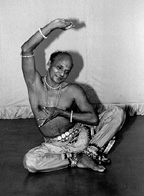Guru Kelucharan Mohapatra
 Guru
Kelucharan Mahapatra is a master and a legend in his chosen field, with
a name now synonymous with Orissi dance throughout the world. Born in a family
of citrakaras or painters, he paints a dancer on to her background.
Guru
Kelucharan Mahapatra is a master and a legend in his chosen field, with
a name now synonymous with Orissi dance throughout the world. Born in a family
of citrakaras or painters, he paints a dancer on to her background.
Born in Raghurajpur on August 1, 1925, young Kelucharan loved the jatras, open air roving theatres of Orissa. His father, a khola (drum) player in these theatres, instilled in him the love of rhythm. The sound of the drums, in harmony with the universe around him, the stars, the fields, the land of Orissa fascinated the child. He also watched closely and imitated the akhadapilas (boys of the gymnasia) as they danced, and he drummed out the rhythm of the mardala on the sides of his buttocks. Painting (the frozen images), rhythm, and movement were to remain the hallmarks of his creations.
Unable to dissuade Kelucharan from indulging in the effeminate art of gotipua dancing, his father allowed him to train under Balabhadra Sahu and finally abandoned him to Guru Sri Mohan Sundar Goswami and his Rasa party. The surrogate father was to become the model in Kelucharan's later relationship with his own students. At the theatre party, Kelucharan learnt not only the arts of acting, singing, and dancing, but also stagecraft, make-up, and choreography. Above all, he trained in both the mardala and the tabla under masters. The theatre group toured six to seven months of the year and rehearsed the remaining months.
When the boy finally left the Rasa theatre party after twelve years, he eked out a living by rolling bidis (indigenous cigarettes), watering betel groves, and carrying sand. Life was eased when he joined Kavichandra Kali Chandra Pattnaik's Annapurna Theatre in Cuttack and earned Rs.7 a month setting the stage, acting occasionally and playing percussion, under Harihar Rao. He trained in khola from Agadhu Moharana and in tabla from Kshetramohan Kar and Harihar Rao. He also learnt Uday Shankar's dance techniques and the use of hand gestures from Guru Dayal Saran.
Life continued evenly for the young man and the dance of Orissa until the major breakthrough with the staging of Vasmasura, created by Guru Pankaj Charan Das. As Siva, Kelucharan was an instant hit. After a few more dance dramas, the young dancer left with Laxmi Priya for Puri, trained and researched some more, to return to Cuttack at the age of 30 as a dance teacher at Kala Vikash Kendra. He remained there for fifteen years, laying the foundation of what is now known as Orissi dance.
With the Sangeet Natak Akademi award in 1966, the title of Padmashree in January 1972, honorary doctorate in January 1982, the Padma Bhushan and the Kalidas Samman in 1989, Kelucharan was finally on the road to fame, from rolling bidis to becoming a legend in his own time, at home and abroad. The most prolific choreographer, Guru Kelucharan worked on some of his masterpieces with Pandit Bhubaneswar Misra as his music composer. The demands for his dances also led to the establishment of training centres in Delhi, Calcutta, and Bombay.
Orissi has come into its own, and it is the guru's job now to translate his movements to paper at the Orissi Research Wing. The Odissi Path Finder has already been published, both in Oriya and in English. His art has come full circle, and often the visual artist in him takes over, transforming the notations into works of art, sometimes to the frustration of his one-time student, now boss, Dr. Kumkum Mohanty.
His primary claim to fame in dance creation lies in his pallavis (flowering of Orissi). The unfolding of the dance through the coming to life of the sculptures in various ragas (melodic moods) with intricate rhythmical patterns is remarkable. He has created pallavis for each of his dance students like a master artist flirting with his artistic creation. Kumkum Mohanty recalls the guru and Pandit Bhubaneswar Misra "in days gone by" working late into the night at her father's house creating pallavis with Kelucharan composing rhythm patterns on the mardala and Pandit Misra composing music on the harmonium (similar to an accordion). Her job she recalls was to remember the compositions so that they would not have to start from scratch the next night. She served as their human tape recorder. The team worked miracles with subjects like Sanjukta and Kumkum. Today the creations have become even more complex and long.